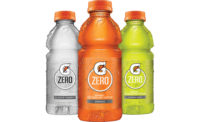What You Need to Know About Natural Sweeteners
By choosing nutritive sweeteners, developers can heighten flavor profiles and therefore lower total sugars

The appeal of unrefined and less-refined natural brown sugars is the variety of color, nuanced flavor, and trace minerals they contribute to formulations.
PHOTO COURTESY OF: International Molasses Corp.

Fruit syrups, such as natural fig syrup, are popular alternative sweeteners due to their rich flavors, enticing colors, and inherent healthful components.
PHOTO COURTESY OF: California Fig Board

Natural sweeteners from sources such as tapioca can help lower sugar calories while adding other beneficial aspects, such as digestive health.
PHOTO COURTESY OF: Anderson Advanced Ingredients, Inc.

PHOTO COURTESY OF: National Honey Board

Among the newest nutritive sweeteners attracting food and beverage developers’ attention are those from Biblical times, derived from carob, dates, figs, and pomegranates.
PHOTO COURTESY OF: Inno-bev, Ltd.

The truly unique—and nostalgic—flavor of maple syrup is experiencing a resurgence as consumers look back toward flavors that evoke emotional meanings.
PHOTO COURTESY OF: Bascom Maple Farms, Inc.

Their darker hues and nuanced flavors of malted grain syrups and powders can help lower total sugar in baked formulations while adding comfort flavors.
PHOTO COURTESY OF: Briess Malt & Ingredients Co.







In today's health-conscious world, much of the conversation around sweeteners focuses on cutting down or even eliminating caloric sweeteners, that is, sucrose, glucose, fructose, and other sugars that impart at least 1kcal/g. These are typically referred to by the generic term “sugar.” However, it must be noted that there are chemical forms of sugar that are lower and even ultra-low in calories (see “Sweet In-Betweens,” below).
In the rush to eliminate these sugars, developers often overlook the variety, richness, and culinary versatility that natural caloric sweeteners provide. Such sugars—also termed “nutritive sweeteners”—not only offer sweetness but can add layers of flavor, color, and even nutritional benefits, all in a clean-label format. These options, while still contributing 3-4kcals/g, can even be used to reduce overall sugar intake by providing deeper, more robust flavors. Each type of sugar has its own unique profile that is suitable for specific culinary applications.
Sucrose 2.0
Sucrose, the disaccharide of glucose and fructose known commonly as “table sugar,” is typically identified in its white, crystalline form. However, sucrose comes in many gradients that vary in texture, color, and flavor. These variations are typically determined by how much processing the sugar undergoes. While white table sugar is highly refined, there are less-refined options that bring a distinct character to foods.
Raw sugar is available in turbinado, demerara, and muscovado varieties, all of which are examples of less-refined sucrose. They range in color from pale gold to dark brown and retain small amounts of molasses, giving them slightly more “earthy” flavors than refined white sugar. Referred to as “natural brown sugars,” some of these also go by the label “whole cane sugar.”
The strength of flavor varies with each of these sugars. Turbinado sugar is a refined raw cane sugar that retains enough molasses to give it a readily identifiable hint of molasses flavor. Demerara sugar has large, golden crystals and contributes a slight—yet rich—toffee-like flavor. Both work well in syrups, coffee drinks, and savory glazes, enhancing depth without overpowering the product.
Muscovado is a darker natural brown sugar. Slightly sticky and intensely flavorful, muscovado is richer in molasses than turbinado and demerara, giving it a deep, earthy sweetness with a robust flavor. It’s ideal for marinades, barbecue sauces, and gingerbread. Because of their more prominent flavors, incorporating these less-refined sugars enhances the final products’ flavor profile, making it possible to reduce overall sugar content while boosting flavor complexity.
Sucrose and their variations are widely available and deliver a consistent and predictable sweetness to food. They are, however, all still “sugar,” devoid of vitamins, minerals, and fiber. They also remain high on the glycemic index, which means they can contribute to blood sugar spikes, energy crashes, and—if overindulged in—weight gain.
Old-School Sweetness
Malted grain syrups, derived from grains such as barley, rice, wheat, and sorghum, are other options for adding both sweetness and a distinct flavor to foods. Malted grain syrups impart a toasty, nutty flavor that works well in pretzels, granola cereals, table syrups, and beverages ranging from coffee drinks to fermented drinks.
Malted sorghum syrup is often used in beer making, providing nutrition for the yeast and a deep flavor and color for the beer. As a breakfast table condiment, sorghum syrup has a long tradition of use in the South, being favored over maple syrup for pancakes and waffles. Recently, malted sorghum syrup has been trending nationally, appearing as a sweetener in baked goods and breakfast items.
Although these syrups are somewhat less sweet than sucrose, they provide nuanced flavors without overwhelming the palate. The lower glucose content also gives these syrups excellent binding capabilities: They can hold a no-bake nutritional bar together without a sticky texture, since they don’t attract moisture in the same way that honey or a simple sucrose syrup would.
For example, brown rice syrup, made from fermented rice starches, is a popular nutritional bar binder that has a cleaner label image than corn syrup. Another plus is that malt flavors are nostalgically tied to chocolate malts and chocolate-coated malt balls, one reason they have been trending in “retro” desserts.
There are some considerations for developers. Some malt syrups can have a strong, distinct flavor and might not work well in all products, especially desserts. Malted syrups are also more expensive than plain sugar and not always as widely available as other sweeteners.
Fruit Sweet
Fruit-based sweeteners are increasingly popular, especially for those seeking natural, plant-based alternatives to processed sugars. These sweeteners bring their own unique flavors and contribute vitamins and minerals as well.
One trending fruit sugar is coconut sugar. It is not a true fruit sugar, though; it is made from the sap of the coconut palm rather than from the coconut itself. Ranging in color from light to dark brown, it’s similar in flavor and performance to turbinado or raw cane sugar. It dissolves readily in liquids and adds sweet, earthy notes similar to those in raw cane and turbinado. It also has trace amounts of minerals as well as antioxidant phytochemicals, including polyphenols and flavonoids.
Sweeteners made from fruits such as apples, raisins, and grapes are entering the market as healthful alternatives to sucrose, corn syrup, and other standbys. These are typically high in fructose (except for grapes, which are high in glucose), so they have the same caloric value as sucrose, glucose, fructose, or corn syrup.
Fruit juices, purées, and concentrates are also alternative sweeteners to sugar, and they’re rising in popularity. They allow for the coveted “no added sugars” claim on labels and product developers using these sweeteners are limited only by their own creativity. Fruit juices and purées are available fresh or frozen, and nearly always year-round.
Sweet potato syrup is a lesser-known but flavorful sweetening option. Made from the juice of sweet potatoes cooked down into a sweet syrup, it has an earthy taste and is rich in potassium and vitamin A.
Biblical Proportions
The Middle East, where sweet syrups have been used for millennia as preservatives and as luxurious treats since Biblical times, has brought us sweetener alternatives from dates, figs, pomegranates, and carob. These are among the oldest cultivated plants, even predating the Bible, in which they are mentioned frequently, as in other ancient literature from the region. Date syrup, as well as fig syrup and pomegranate syrup—pantry staples in the Middle East—all have been trending recently in the West.
These are dark, thicker, and more distinct in their respective flavors than maple or grain-based syrups. They can be used in more culturally traditional desserts, sauces, and pastries to provide a touch of the exotic that appeals to the growing consumer interest in global flavors.
Fig syrup is derived from figs that are boiled-down, strained, and filtered. It has a rich, fruity taste that pairs well with cheeses, meats, and desserts. These syrups can act as both sweeteners and flavor enhancers, reducing the need for additional sugars while enriching the taste profile.
Tart-sweet pomegranate syrup, often used in Middle Eastern cuisine, is made by reducing pomegranate juice. It has a vibrant, tangy flavor that works well in both savory products such as sauces and in desserts. Its bold flavor means it can be used sparingly in formulations, although for some products it might require pairing with a more traditional sweetener such as sucrose. Pomegranate syrup lends an attractive natural red color to products as well.
One of the more popular of these traditional ingredients is date sugar. Made from ground, dehydrated dates, date sugar is rich in fiber and nutrients, including potassium, iron, and magnesium. Its caramel-like flavor works well in baked goods. Since it has such a deep, intense flavor compared to sucrose, less might be needed in a formulation. Like sucrose, date sugar provides bulk, texture, and flavor complexity. Date sugar does not dissolve as well as refined sugar, so it is not an ideal choice for cold beverages and delicate baked goods.
Carob sweeteners, available in both syrup and granulated formats, are another turn-to for adding sweetness. Made from the pods of the carob tree, unrefined carob syrup has an almost chocolate-like flavor. Lighter versions of the syrup still retain hints of the unique flavor, and the granulated form has a clean sweetness that still carries those notes.
Carob sweeteners are around a third lower in calories than honey or sugar and can be used to sweeten desserts, smoothies, and even savory products. Carob chips do not melt as easily as chocolate chips, so they can be used in baked cookie applications where a higher chip melting point is called for. Carob sugar has become a popular sweetener in better-for-you beverages of late. Also, the combination of its clean label advantage, health halo, and tradition allows for great marketing opportunities.
Simply Syrup
Maple syrup, made from the sap of sugar maple trees, is another natural sweetener with a distinct flavor. Because of how it is processed, it is more expensive than many other sweeteners. Available in different grades, from light amber to dark robust, its unmistakable flavor profile lends itself well to savory sauces and marinades.
Maple syrup is sweeter than table sugar, so a smaller amount can achieve the desired sweetness. Its depth of flavor also allows for lower overall sugar usage, especially in desserts and sauces. Maple syrup can be purchased as a single-strength syrup or in a more concentrated form. The concentrated form can reduce shipping cost and allows it to be used in formulas that need less water. By concentrating it, it can be treated more like a flavoring. Maple syrup contains vitamins and minerals such as zinc and manganese.
Agave syrup, made from the sap of the agave plant, gained popularity as a “natural” alternative to processed sugars, especially high-fructose corn syrup (HFCS), which it was commonly marketed against as a “healthier” alternative (see “HFCS ABC,” below). This caused its popularity to wane, however, when it became more widely known that agave syrup typically is a higher-fructose syrup than HFCS. Whereas HFCS can range in ratio to glucose from 45-55% fructose, agave ranges from 60-90% fructose.
Agave has a mild flavor and a lower glycemic index than table sugar, meaning it causes less of a spike in blood sugar levels. Agave’s neutral flavor makes it suitable for a variety of products, from beverages to baked goods. Unlike honey, maple syrup, and other natural sweeteners, agave syrup brings only sweetness and not competing flavors to the product. High-fructose sweeteners are always somewhat sweeter than sucrose, so smaller amounts are needed in formulations.
While the current trend in sweeteners focuses heavily on lowering sugar, it is essential to remember that caloric sweeteners offer a depth and variety of flavors that, with few exceptions, are not available from zero- and low-calorie alternative sweeteners. They can elevate cooking and baking formulations with distinct flavor notes and functionality.
From the many forms of sucrose to the natural sweetness of fruits, honey, and syrups, these ingredients not only provide sweetness but also bring complexity, richness, and nutritional benefits. Some even allow for lower total sugar contents in a product, while providing overall healthier halos and cleaner labels to a comprehensive array of foods and beverages.
Need to know more? You can find a wealth of articles, videos, podcasts, infographics, and white papers on both caloric and low-/zero-calorie sweeteners of all types.
Multibillion Dollar Baby
The industrial sugar market is projected to reach USD59.1 billion by 2028 from USD46.4 billion by 2023, at a CAGR of 5.0% during the forecast period in terms of value. The market for industrial sugar by solution is experiencing growth due to the increasing demand for processed and convenience food and beverages globally.—“Industrial Sugar Market by Type (White Sugar, Brown Sugar, & Liquid Sugar), Application (dairy Products, Bakery Products, Confectionery, Beverages, & Pharmaceuticals), Source (Sugarcane & Sugar Beet and Region – Global Forecast to 2028” (MarketsandMarkets [DF1] , Inc., 16 Oct., 2024)
Sweet In-Betweens
For developers wanting to have their sugar-sweetened cake and cut its calories too, the “new” natural low-calorie sugar tagatose might be a good option. With a flavor, sweetness, and texture nearly identical to sucrose, it can be used in many formulations as a 1:1 sucrose replacer with two-thirds fewer calories. It is, however, non-hygroscopic. Similarly, allulose, a natural epi-isomer of fructose boasting a mere 0.2-0.4kcals/g, can also be used in many formulations as a direct sucrose replacer, although it has higher hygroscopy and a slightly lower sweetness level than sucrose. Both tagatose and allulose are reducing sugars that form Maillard reaction browning.
Molasses’ Comeback
Molasses, the thick, dark syrup that is a byproduct of refining sugar cane or sugar beets, has been making a comeback. It has an intense flavor, often described as bittersweet, and comes in various grades depending on how long it has been processed. Blackstrap molasses is the most concentrated and contains significant amounts of the minerals iron, calcium, magnesium, and potassium. Molasses is particularly valued in baking, especially for gingerbread and cookies, where it adds not only sweetness but also moisture and depth of flavor. Because of its strong taste, it can be used sparingly, helping to reduce the overall sugar content of a product while still delivering complexity in taste. Blackstrap molasses in small quantities can be used to recreate the experience of the popular “raw cookie dough” flavor in baked goods and nutritional bars. Molasses has some great applications; however, some consumers find the bold flavor to be overpowering, and it can dominate a formulation if too much is used.
HFCS ABCs
While the controversy over high-fructose corn syrup (HFCS) has largely diminished, HFCS remains a less-favored sweetener for many product developers. Chemically, it is virtually identical to sucrose: Both are disaccharides made up of half fructose and half glucose. As a processed syrup, HFCS contains small amounts of free fructose and glucose monosaccharides. In HFCS, the percentage of fructose can vary slightly on either side of the 50-50 divide, anywhere from 42-68% fructose to glucose to as high as 90% fructose, depending on manufacturing specifics. However, it most commonly comes in at around 52-55% fructose to glucose. The name, somewhat of a misnomer, is said to have been coined as a way of distinguishing the sweetener from table sugar, with the “high-fructose” designation based on a comparison to commercial-grade glucose syrup.
Honey of an Original
Honey is the oldest known sweetener, depicted in cave paintings dating back more than 8,000 years. It remains a favorite due to its complex flavor and potential health benefits. It varies in taste, depending on the floral source and region. Honey is made up predominantly of the monosaccharide fructose and is sweeter and more intense than table sugar. It is highly hygroscopic, attracting more moisture than sucrose, which makes it less ideal as a binding agent. However, when used in smaller amounts, it can be blended with other syrups, like brown rice syrup, that have better binding capabilities and provide extra flavor and depth. Its unique flavors—ranging from light and floral to dark and earthy—can elevate everything from bakery items to salad dressings and marinades. While it has strong antimicrobial properties, honey does carry a botulism spore risk and should not be used in products that would be given to infants younger than one year old.
[DF1] Supposed to have no spaces
Looking for a reprint of this article?
From high-res PDFs to custom plaques, order your copy today!














